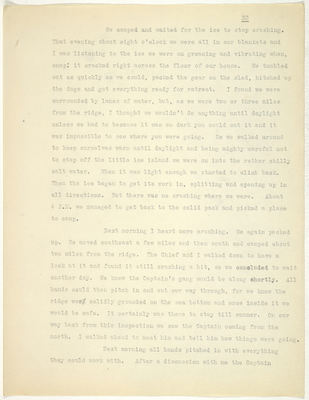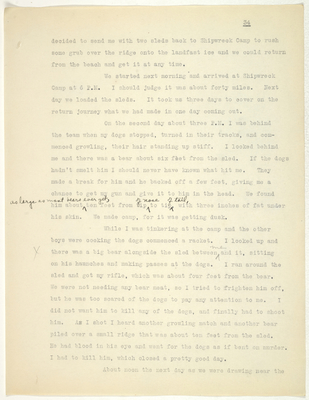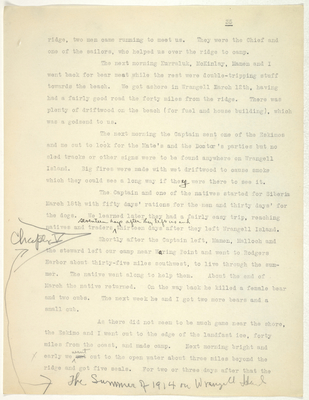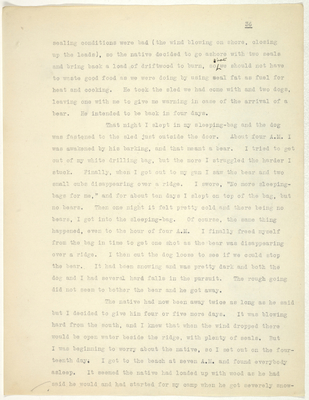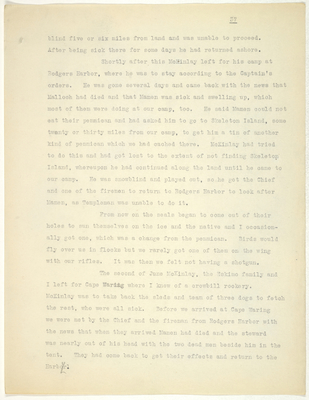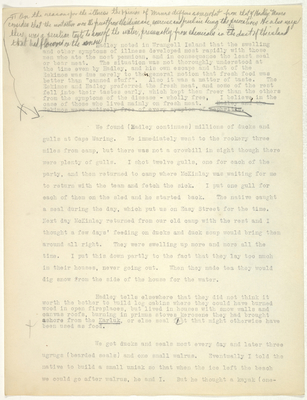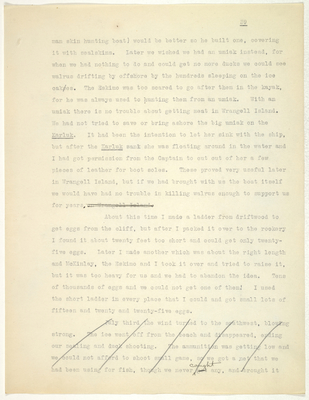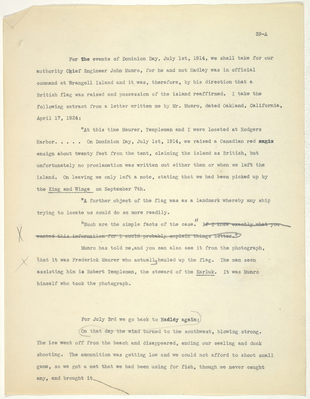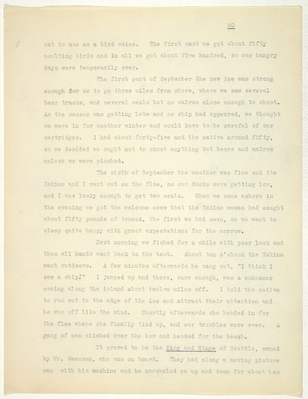Pages That Need Review
stefansson-wrangel-09-26-001
stefansson-wrangel-09-26-001-048
33
We camped and waited for the ice to stop crushing. That evening about eight o’clock we were all in our blankets and I was listening to the ice we were on groaning and vibrating when, snap! it cracked right across the floor of our house. We tumbled out as quickly as we could, packed the gear on the sled, hitched up the dogs and got everything ready for retreat. I found we were surrounded by lanes of water, but, as we were two or three miles from the ridge, I thought we wouldn’t do anything until daylight unless we had to because it was so dark you could cut it and it was impossible to see where you were going. So we walked around to keep ourselves warm until daylight and being mighty careful not to step off the little ice island we were on into the rather chilly salt water. When it was light enough we started to climb back. Then the ice began to get its work in, splitting and opening up in all directions. But there was no crushing where we were. About 4 P.M. we managed to get back to the solid pack and picked a place to camp.
Next morning I heard more crushing. We again packed up. We moved southeast a few miles and then south and camped about two miles from the ridge. The Chief and I walked down to have a look at it and found it still crushing a bit, so we concluded to wait another day. We knew the Captain's gang would be along shortly. All hands could then pitch in and cut our way through, for we knew the ridge was solidly grounded on the sea bottom and once inside it we would be safe. It certainly was there to stay till summer. On our way back from this inspection we saw the Captain coming from the north. I walked ahead to meet him and tell him how things were going.
Next morning all hands pitched in with everything they could work with. After a discussion with me the Captain
stefansson-wrangel-09-26-001-049
34
decided to send me with two sleds back to Shipwreck Camp to rush some grub over the ridge onto the landfast ice and we could return from the beach and get it at any time.
We started next morning and arrived at Shipwreck Camp at 6 P.M. I should judge it was about forty miles. Next day we loaded the sleds. It took us three days to cover on the return journey what we had made in one day coming out.
On the second day about three P.M. I was behind the team when my dogs stopped, turned in their tracks, and commenced growling, their hair standing up stiff. I looked behind me and there was a bear about six feet from the sled. If the dogs hadn’t smelt him I should never have known what hit me. They made a break for him and he backed off a few feet, giving me a chance to get my gun and give it to him in the head. We found him about as large as meat bears ever get, ten feet from tip of nose to tip of tail with three inches of fat under his skin. We made camp, for it was getting dusk.
While I was tinkering at the camp and the other boys were cooking the dogs commenced a racket. I looked up and there was a big bear alongside the sled between me and it, sitting on his haunches and making passes at the dogs. I ran around the sled and got my rifle, which was about four feet from the bear. We were not needing any bear meat, so I tried to frighten him off, but he was too scared of the dogs to pay any attention to me. I did not want him to kill any of the dogs, and finally had to shoot him. As I shot I heard another growling match and another bear piled over a small ridge that was about ten feet from the sled. He had blood in his eye and went for the dogs as if bent on murder. I had to kill him, which closed a pretty good day.
About noon the next day as we were drawing near the
stefansson-wrangel-09-26-001-050
35
ridge, two men came running to meet us. They were the Chief and one of the sailors, who helped us over the ridge to camp.
The next morning Kurraluk, McKinlay, Mamen and I went hack for bear meat while the rest were double-tripping stuff towards the heach. We got ashore in Wrangell March 12th, having had a fairly good road the forty miles from the ridge. There was plenty of driftwood on the heach (for fuel and house building), which was a godsend to us.
The next morning the Captain sent one of the Eskimos and me out to look for the Mate’s and the Doctor’s parties hut no sled tracks or other signs were to he found anywhere on Wrangell Island. Big fires were made with wet drift-wood to cause smoke which they could see a long way if therey were there to see it.
The Captain and one of the natives started for Siberia March 18th with fifty days’ rations for the men and thirty- days’ for the dogs. We learned later, they had a fairly easy trip, reaching natives and traders seventeen days after they left us and thirteen days after they left Wrangell Island.
Shortly after the Captain left, Mamen, Malloch and the steward left our camp near Waring Point and went to Rodgers Harbor about thirty-five miles southwest, to live through the summer. The native went along to help them. About the end of March the native returned. On the way back he killed a female hear and two cubs. The next week he and I got two more hears and a small cub.
As there did not seem to he much g:ame near the shore, the Eskimo and I went out to the edge of the landfast ice, fortymiles from the coast, and made camp. Next morning bright and early we wnt went out to the open water about three miles beyond the ridge and got five seals. For two or three days after that the
The Summer of 1914 on Wrangell Island
stefansson-wrangel-09-26-001-051
36
sealing conditions were bad (the wind blowing on shore, closing up the leads), so the native decided to go ashore with two seals and bring back a load of driftwood to burn, so that we should not have to waste good food as we were doing by using seal fat as fuel for heat and cooking. He took the sled we had come with and two dogs, leaving one with me to give me warning in case of the arrival of a bear. He intended to be back in four days.
That night I slept in my sleeping-bag and the dog was fastened to the sled just outside the door. About four A.M. I was awakened by his barking, and that meant a bear. I tried to get out of my white drilling bag, but the more I struggled the harder I stuck. Finally, when I got out to my gun I saw the bear and two small cubs disappearing over a ridge. I swore, "No more sleepingbags for me," and for about ten days I slept on top of the bag, but no bears. Then one night it felt pretty cold and there being no bears, I got into the sleeping-bag. Of course, the same thing happened, even to the hour of four A.M. I finally freed myself from the bag in time to get one shot as the bear was disappearing over a ridge. I then cut the dog loose to see if we could stop the bear. It had been snowing and was pretty dark and both the dog and I had several hard falls in the pursuit. The rough going did not seem to bother the bear and he got away.
The native had now been away twice as long as he said but I decided to give him four or five more days. It was blowing hard from the south, and I knew that when the wind dropped there would be open water beside the ridge, with plenty of seals. But I was beginning to worry about the native, so I set out on the fourteenth day. I got to the beach at seven A.M. and found everybody asleep. It seemed the native had loaded up with wood as he had said he would and had started for my camp when he got severely snow-
stefansson-wrangel-09-26-001-052
37
blind five or six miles from land and was unable to proceed. After being sick there for some days he had returned ashore.
Shortly after this McHinlay left for his camp at Rodgers Harbor, where he was to stay according to the Captain’s orders. He was gone several days and came back with the news that Malloch had died and that Mamen was sick and swelling up, which most of them were doing at our camp, too. He said Mamen could not eat their pemmican and had asked him to go to Skeleton Island, some twenty or thirty miles from our camp, to get him a tin of another kind of pemmican which we had cached there. McKinlay had tried to do this and had got lost to the extent of not finding Skeleton Island, whereupon he had continued along the land until he came to our camp. He was snowblind and played out, so he got the Chief and one of the firemen to return to Rodgers Harbor to look after Mamen, as Tempieman was unable to do it.
From now on the seals began to come out of their holes to sun themselves on the ice and the native and I occasionally got one, which was a change from the pemmican. Birds would fly over us in flocks but we rarely got one of them on the wing with our rifles. It was then we felt not having a shotgun.
The second of June McKinlay, the Eskimo family and I left for Cape Waring where I knew of a crowbill rookery. McKinlay was to take back the sleds and team of three dogs to fetch the rest, who were all sick. Before we arrived at Cape Waring we were met by the Chief and the fireman from Rodgers Harbor with the news that when they arrived Mamen had died and the steward was nearly out of his head with the two dead men beside him in the tent. They had come back to get their effects and return to the Harbour.
stefansson-wrangel-09-26-001-053
38
Hadley noted in Wrangell Island that the swelling and other symptoms of illness developed most rapidly with those men who ate the most pemmican, and in consequence the least seal or hear meat. The situation was not thoroughly understood at the time even by Hadley, and his own escape and that of the Eskimos was due merely to their general notion that fresh food better than "canned stuff”. Also it was a matter of taste. The Eskimos and Hadley preferred the fresh meat, and some of the rest fell into their tastes early, which kept them freer than the others symptoms of the disease - wholly free, I believe, in the case of those who lived mainly on fresh meat. Hadley and the Eskimos were entirely free from every symptom of naphritis.
On the reasons for the illness the opinion of Munro differs somewhat from that of Handley. Munro Consider that the most active was the freest from the disease, exercise and freed air being the preventives. He also says there was a peculiear tast to some of the water, presumable from chemicals in the dust of the island that had flown on the snow.
We fund (Hadley continues) millions of ducks and gulls at Camp Waring. We immediately went to the rookery three miles from camp, but there was not a crowbill in sight though there were plenty of gulls. I shot twelve gulls, one for each of the party, and then returned to camp where McKinley was waiting for me to return with the team and fetch the sick. I put one gull for each of them on the sled and he started back. The native caught a seal during the day, which put us on Easy Street for the time. Next day McKinlay returned from our old camp with the rest and I thought a few days' feeding on ducks and duck soup would bring them around all right. They were swelling up more and more all the time. I put this down partly to the fact that they lay too much in their houses, never going out. When they made tea they would dig snow from the side of the house for the water.
Hadley tells elsewhere that they did not think it worth the bother to build log cabins where they could have burned wood in open fireplaces, but lived in houses with snow walls and canvas roofs, burning in primus stoves kerosene they had brought ashore from the Karluk, or else seal feat that might otherwise have in used as food.
We got ducks and seals most every day and later three ugrugs (bearded seals) and one small walrus. Eventually I told the native to build a small umiak so that when the ice left the beach we could go after walrus, he and I. But he thought a kayak (one-
stefansson-wrangel-09-26-001-054
39
man skin hunting boat) would he better so he built one, covering it with sealskins. Later we wished we had an umiak instead, for when we had nothing to do and could get no more ducks we could see walrus drifting by offshore by the hundreds sleeping on the ice cakses. The Eskimo was too scared to go after them, in the kayak, for he was always used to hunting them from an umiak. With an umiak there is no trouble about getting meat in Wrangell Island. We had not tried to save or bring ashore the big umiak on the Karluk. It had been the intention to let her sink with the ship, but after the Karluk sank she was floating around in the water and I had got permission from the Captain to cut out of her a few pieces of leather for boot soles. These proved very useful later in Wrangell Island, but if we had brought with us the boat itself we would have had no trouble in killing walrus enough to support us for years, on Wrangell Island.
About this time I made a ladder from driftwood to get eggs from the cliff, but after I packed it over to the rookery I found it about twenty feet too short and could get only twentyfive eggs. Later I made another which was about the right length and McKinlay, the Eskimo and I took it over and tried to raise it, but it was too heavy for us and we had to abandon the idea. Tens of thousands of eggs and we could not get one of them! I used the short ladder in every place that I could and got small lots of fifteen and twenty and twenty-five eggs.
July third the wind turned to the southwest, blowing strong. The ice went off from the beach and disappeared, ending our sealing and duck shooting. The ammunition was getting low and we could not afford to shoot small game, so we got a net that we had been using for fish, though we never got caught any, and brought it
stefansson-wrangel-09-26-001-055
39-A
For the events of Dominion Day, , we shall take for our authority Chief Engineer John Munro, for he and not Hadley was in official command at Wrangell Island and it was, therefore, by his direction that a British flag was raised and possession of the island reaffirmed. I take the following extract from a letter written me by Mr. Munro, dated Oakland, California, :
"At this time Maurer, Templeman and I were located at Rodgers Harbor.... On Dominion Day, , we raised a Canadian red xxxxx ensign about twenty feet from the tent, claiming the island as British, but unfortunately no proclamation was written out either then or when we left the island. On leaving we only left a note, stating that we had been picked up by the King and Winge on September 7th.
"A further object of the flag was as a landmark whereby any ship trying to locate us could do so more readily.
"Such are the simple facts of the case." If I knew exactly what you wanted this information for I could probably explain things better."
Munro has told me, and you can also see it from the photograph, that it was Frederick Maurer who actually hauled up the flag. The man seen assisting him is Robert Templeman, the steward of the Karluk. It was Munro himself who took the photograph.
For July 3rd we go back to Hadldy again:
On that day the wind turned to the southwest, blowing strong. The ice went off from the beach and disappeared, ending our sealing and duck shooting. The ammunition was getting low and we could not afford to shoot small game, so we got a net that we had been using for fish, though we never caught any, and brought it
stefansson-wrangel-09-26-001-056
40
out to use as a bird seine. The first cast we got about fifty moulting birds and in all we got about five hundred, so our hungry days were temporarily over.
The first part of September the new ice was strong enough for us to go three miles from shore, where we saw several bear tracks, and several seals but no walrus close enough to shoot. As the season was getting late and no ship had appeared, we thought we were in for another winter and would have to be careful of our cartridges. I had about forty-five and the native around fifty, so we decided we ought not to shoot anything but bears and walrus unless we were pinched.
The sixth of September the weather was fine and the Eskimo and I went out on the floe, as our ducks were getting low, and I was lucky enough to get two seals. When we came ashore in the evening we got the welcome news that the Eskimo woman had caught about fifty pounds of tomcod, the first we had seen, so we went to sleep quite happy with great expectations for the morrow.
Next morning we fished for a while with poor luck and then all hands went back to the tent. About ten o’clock the Eskimo went outdoors. A few minutes afterwards he sang out, "I think I see a ship!" I jumped up and there, sure enough, was a schooner coming along the island about twelve miles off. I told the native to run out to the edge of the ice and attract their attention and he was off like the wind. Shortly afterwards she headed in for the floe where she finally tied up, and our troubles were over. A gang of men climbed over the bow and headed for the beach.
It proved to be the King and Winge of Seattle, owned by Mr. Swenson, who was on board. They had along a moving picture man with his machine and he marshaled us up and down for about ten
stefansson-wrangel-09-26-001-057
41
minutes, taking films of us. When that was finished we went on board and started for Nome where we arrived .
(Signed) John Hadley.
We have been following Hadley's manuscript, but nearly every impression I have of Wrangell Island and the adventures and trials of Hadley and his companions comes not from his written account, though the manuscript is about five times as long as the part here printed, but from the stories he told me during the longwinter evenings, sometimes with excessive elaboration but more often in brief, disjointed sentences that would have been incomprehensible to a listener not thoroughly familiar with the whole background of polar environment, sailor ethics, and human nature as it manifests itself in remote isolation under circumstances different from the ordinary routine of sailor life.
Without a trace of callousness but with a recognition of the inevitable, Hadley believed that a second winter on Wrangell Island would have meant the death of all those not active and self supporting. This was not so much because the productive hunters would have refused to share what they got with the others, but rather because he believed both food and exercise to be necessary for health. It seemed to me that the lives of the whole party were saved by the King and Winge, but Hadley always maintained stoutly that himself, the Eskimos and probably two or three of the white men would have lived through the winter and through any number of successive winters. He believed also that these same people could have crossed to the mainland of Siberia, a hundred miles away, after the middle of the winter, and he said they would have done so except for the possibility
